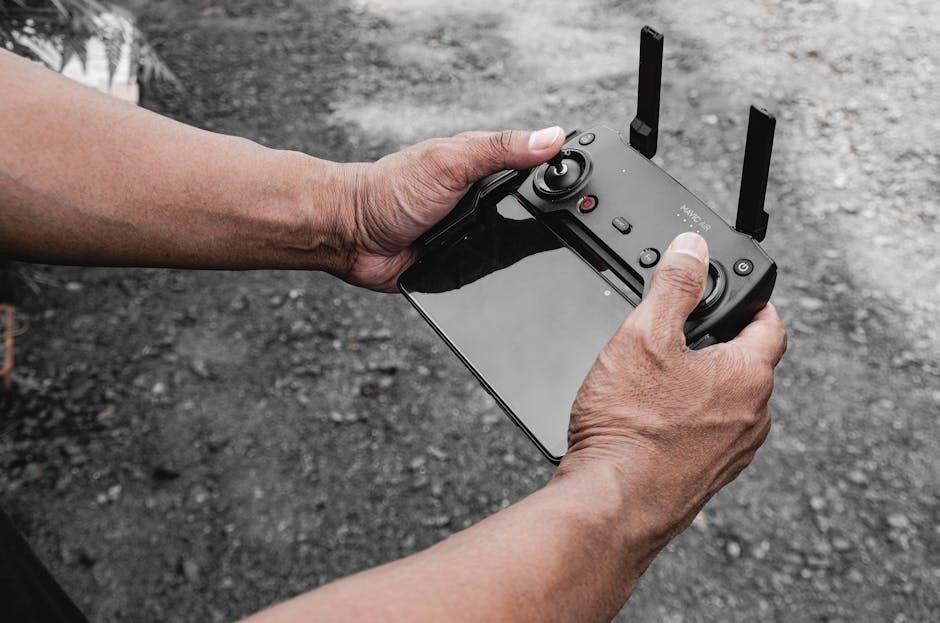A solar charge controller regulates energy flow from solar panels to batteries‚ preventing overcharging and protecting the system. It ensures efficient and safe energy storage and optimization.
1.1 What is a Solar Charge Controller?
A solar charge controller is an essential device that regulates the energy flow from solar panels to batteries. Its primary function is to prevent overcharging‚ ensuring the battery operates within safe voltage levels. This device protects the system from potential damage caused by excessive energy input. Solar charge controllers come in two main types: PWM (Pulse Width Modulation) and MPPT (Maximum Power Point Tracking)‚ each offering distinct advantages. They also provide critical protections such as overcharge prevention‚ short circuit protection‚ and temperature compensation. By maintaining optimal charging conditions‚ a solar charge controller extends battery life and enhances overall system efficiency and reliability.
1.2 Importance of a Solar Charge Controller in Solar Systems
A solar charge controller is crucial for maintaining the health and efficiency of solar power systems. It prevents overcharging and discharge of batteries‚ protecting them from damage caused by excessive voltage levels. By regulating energy flow‚ it ensures optimal charging and discharging‚ extending battery lifespan. The controller also safeguards the system from short circuits‚ overloads‚ and reverse polarity‚ enhancing overall safety. Additionally‚ it optimizes energy harvest by efficiently managing power input from solar panels. Without a charge controller‚ solar systems would be prone to inefficiency‚ damage‚ and shortened component life‚ making it an indispensable component for reliable and sustainable energy generation.

Safety Precautions
Always follow safety guidelines to avoid electrical hazards. Ensure proper handling and installation to prevent damage or injury. Compliance with international safety standards is essential for reliable operation.
2.1 General Safety Guidelines
Always disconnect solar panels before handling the charge controller to prevent electrical shocks. Ensure the battery is connected first to avoid system damage. Never connect solar panels directly without proper configuration. Always follow correct polarity: positive to positive‚ negative to negative. Avoid overcurrent situations by using appropriate wire sizes. Wear protective gear‚ including gloves and goggles‚ when working with electrical systems. Keep the controller away from flammable gases and ensure proper ventilation. Never touch electrical terminals with bare hands. Follow all local electrical codes and regulations. Regularly inspect connections for damage or wear. Ensure the system is grounded correctly for safety. Always refer to the manual for specific precautions.

2.2 Handling and Storage Instructions
Handle the charge controller with care to avoid physical damage. Store it in a dry‚ cool place away from direct sunlight. Ensure the temperature range is between -20°C and 60°C. Keep the controller away from children and pets. Avoid stacking heavy objects on top of it. When storing‚ disconnect all wires and cover terminals to prevent corrosion. Use protective packaging to shield against shocks and vibrations. Never expose the controller to chemicals or flammable gases. For long-term storage‚ follow the manufacturer’s guidelines. Regularly inspect stored units for damage. Always ensure the controller is powered down before moving or storing. Maintain the unit in its original packaging if possible.
2.3 Compliance with International Safety Standards
This solar charge controller meets rigorous international safety standards‚ including UL and CE certifications. These standards ensure it operates safely under various conditions and provides reliable performance. Compliance with these regulations guarantees protection against overcharge‚ short circuits‚ and overheating. The controller is designed to meet IEC‚ ISO‚ and RoHS requirements‚ ensuring environmental sustainability and user safety. Always verify the certification marks to ensure authenticity. Adherence to these standards ensures the controller is compatible with global solar systems and meets the highest safety expectations. This compliance is crucial for both residential and commercial solar installations‚ providing users with peace of mind and long-term reliability.

Installation Steps

Install the charge controller by connecting solar panels‚ battery‚ and load. Ensure proper wiring‚ secure mounting‚ and follow safety guidelines for a reliable solar system setup.
3.1 Unpacking and Inventory Check
Begin by carefully unpacking the solar charge controller and verifying all components are included. Check for the controller unit‚ user manual‚ mounting hardware‚ and connecting cables. Ensure the model and specifications match your system requirements. Inspect the controller for any visible damage or defects. Compare the items with the packing list provided in the manual. If any components are missing or damaged‚ contact the supplier immediately. Familiarize yourself with the controller’s features and ports before proceeding with installation. This step ensures a smooth and safe setup process‚ avoiding potential issues during operation. Proper inventory checks are essential for a successful installation.
3.2 Choosing the Right Location for Installation
Selecting a suitable location for your solar charge controller is crucial for optimal performance and safety. Ensure the area is well-ventilated‚ dry‚ and protected from direct sunlight to avoid overheating. Avoid locations with flammable materials or high humidity. The controller should be installed near the battery to minimize cable lengths‚ reducing energy loss and voltage drop. Ensure easy access for maintenance and monitoring. Mount the controller securely on a flat surface‚ using the provided hardware. Avoid areas prone to vibrations or extreme temperatures. Proper positioning ensures reliable operation‚ longevity‚ and compliance with safety standards. Always follow the manufacturer’s recommendations for ideal placement.
3.3 Wiring Diagrams and Connections
Refer to the provided wiring diagrams for a clear understanding of connections. Connect solar panels to the controller’s input terminals‚ ensuring correct polarity (positive to positive‚ negative to negative). Next‚ link the battery to the controller’s output terminals‚ following the same polarity rules. Use the appropriate gauge wire to minimize voltage drop. Connect any additional components‚ such as an inverter or load‚ to the specified terminals. Double-check all connections for tightness and correctness. Power the system in the correct sequence: solar panels first‚ then the battery‚ and finally the load. Always consult the manufacturer’s manual for specific wiring instructions and compatibility guidelines.
3.4 Mounting the Charge Controller
Mount the charge controller in a well-ventilated‚ dry location‚ away from direct sunlight and heat sources to prevent overheating. Use the provided mounting brackets to secure it firmly to a wall or surface. Ensure the device is level and accessible for monitoring. Avoid areas with high humidity or exposure to water. If installing in an enclosure‚ ensure proper airflow. Tighten all fasteners securely but avoid overtightening‚ which may damage the unit. Always follow the manufacturer’s recommendations for mounting hardware and location to ensure optimal performance and longevity of the charge controller. This step is crucial for maintaining system efficiency and safety.

Features and Specifications
Solar charge controllers offer advanced features like MPPT technology‚ built-in protections‚ and display capabilities for real-time monitoring. They ensure efficient energy management with high accuracy and safety standards.
4.1 Types of Solar Charge Controllers (PWM vs. MPPT)
Solar charge controllers are primarily categorized into two types: Pulse Width Modulation (PWM) and Maximum Power Point Tracking (MPPT). PWM controllers are simpler‚ cost-effective‚ and suitable for small-scale systems. They regulate battery charging by modulating the width of the pulse to the battery‚ ensuring overcharge protection. MPPT controllers‚ on the other hand‚ are more advanced‚ utilizing MPPT technology to optimize energy harvest by tracking the maximum power point of the solar panel. MPPT controllers are ideal for larger‚ more complex systems‚ offering higher efficiency and better performance in varying conditions. Choosing the right type depends on system size‚ budget‚ and energy requirements.

4.2 Ratings and Capacity (Voltage and Current)
Ratings and capacity are critical specifications for solar charge controllers‚ determining their suitability for specific systems. Voltage rating refers to the maximum input voltage from solar panels‚ while current rating indicates the maximum charge current. Controllers are typically available in 12V‚ 24V‚ 48V‚ or higher configurations. Capacity is often expressed in amps (e.g;‚ 20A‚ 40A)‚ reflecting the maximum current they can handle. Properly matching the controller’s voltage and current ratings to the solar array and battery ensures efficient energy transfer‚ prevents overload‚ and maximizes system performance and safety. Always refer to the user manual for specific rating requirements and compatibility guidelines.
4.3 Maximum Power Point Tracking (MPPT) Technology
Maximum Power Point Tracking (MPPT) technology optimizes energy extraction from solar panels by continuously adjusting the system to match the panel’s maximum power point. This advanced method ensures maximum energy capture‚ even under varying light and temperature conditions. MPPT controllers dynamically regulate the flow of energy‚ preventing losses and maximizing battery charging efficiency. Unlike PWM controllers‚ MPPT technology allows higher voltage solar panels to charge lower voltage battery systems effectively. This feature is particularly beneficial in cloudy or low-light environments. Renogy’s Rover series‚ for instance‚ uses MPPT technology with 8 electronic protections‚ ensuring safe and efficient energy management for solar systems.
4.4 Built-in Protections (Overcharge‚ Short Circuit‚ etc.)
Built-in protections in solar charge controllers ensure system safety and longevity. Overcharge protection prevents batteries from exceeding safe voltage levels‚ while short circuit protection detects and interrupts faulty connections. Many controllers also feature reverse polarity protection‚ preventing damage from incorrect wiring. Additionally‚ some models include overvoltage‚ undervoltage‚ and thermal protection to safeguard against extreme temperatures and voltage fluctuations. Renogy’s Rover series‚ for example‚ offers eight electronic protections‚ actively monitoring system conditions to prevent damage. These integrated safeguards are essential for maintaining reliable operation and preventing potential hazards‚ ensuring a secure and durable solar energy storage solution.
4.5 Display and Monitoring Capabilities
Modern solar charge controllers feature advanced display and monitoring capabilities‚ enabling users to track system performance in real time. Many controllers include an LCD screen showing key metrics such as input voltage‚ output current‚ battery state of charge‚ and temperature. Some models‚ like the Renogy Rover series‚ offer backlit displays for better visibility in low-light conditions. Additionally‚ controllers may provide detailed monitoring of charging stages‚ error codes‚ and historical data. Advanced models integrate with apps like the Renogy BT App‚ allowing remote monitoring via Bluetooth or Wi-Fi. These features ensure users can optimize system performance‚ troubleshoot issues‚ and maintain efficiency effortlessly.
4.6 Communication Interfaces (Bluetooth‚ Wi-Fi‚ etc.)
Modern solar charge controllers often include communication interfaces like Bluetooth and Wi-Fi for enhanced connectivity. These interfaces allow users to monitor and control their solar systems remotely using apps like the Renogy BT App. Bluetooth-enabled controllers provide reliable short-range connections‚ while Wi-Fi offers broader network integration. Some models support both‚ ensuring flexibility for different setups. These features enable real-time data access‚ parameter customization‚ and firmware updates. Remote monitoring simplifies system management‚ allowing users to track performance and address issues without physical access to the controller. Advanced models may also integrate with smart home systems‚ offering seamless energy management and improving overall system efficiency and user convenience.

Operating Instructions
Solar charge controllers require proper setup and monitoring to ensure optimal performance. Follow initial configuration steps‚ monitor energy flow‚ and reset if necessary for reliable operation.
5.1 Initial Setup and Configuration
Start by connecting the battery to the charge controller‚ ensuring correct polarity to avoid damage. Next‚ attach the solar panels‚ following the wiring diagram. Connect the load (e.g.‚ inverter or appliances) to the controller’s output terminals. Use the Renogy BT app or onboard buttons to configure settings like battery type‚ charging parameters‚ and discharge limits. Turn on the system and verify operation by checking LED indicators or the app. Refer to the manual for specific voltage and current settings tailored to your system. Proper initial setup ensures efficient energy management and protects your solar system from potential issues. Always follow safety guidelines during setup.
5.2 Monitoring System Performance
Monitor your solar system’s performance using the charge controller’s built-in display or the Renogy BT app. The display shows real-time data like voltage‚ current‚ and battery state of charge. Use the app to track historical performance‚ ensuring optimal energy harvesting. Check LED indicators for system status and alarms. Regularly review charge and discharge cycles to detect issues early. Ensure all readings align with expected values based on weather and load demand. Monitoring helps maintain efficiency‚ prevents faults‚ and extends system lifespan. For detailed data‚ refer to the user manual or contact technical support for advanced diagnostic tools.
5.3 Understanding Indicator Lights and Alarms
The solar charge controller features indicator lights and alarms to provide real-time system status updates. Green lights typically indicate normal operation‚ while red lights signal faults like overcharge or short circuits. Alarms may sound for critical issues‚ such as thermal overload or reverse polarity. Refer to the user manual for specific light and alarm codes to diagnose and resolve problems quickly. Understanding these indicators helps maintain system health and prevents potential damage. Always address alarms promptly to ensure safe and efficient operation of your solar power system.
5.4 Resetting the Charge Controller (Renogy Example)
Resetting your Renogy charge controller can resolve operational issues. Start by disconnecting the battery to ensure safety. Locate the reset button‚ typically found on the rear or side. Press and hold it for 5 seconds until the LEDs flash. Reconnect the battery and monitor the system. This process restores default settings and clears faults. If issues persist‚ refer to the user manual or update firmware via the Renogy BT App. Always follow safety guidelines to avoid damage and ensure optimal performance of your solar power system.

Maintenance and Troubleshooting
- Regularly inspect connections and clean terminals to ensure proper conductivity.
- Check cables for damage and replace if necessary.
- Monitor system performance and address common issues promptly.
- Ensure firmware is updated for optimal functionality.
6.1 Regular Maintenance Checks
Performing regular maintenance ensures the solar charge controller operates efficiently. Begin by inspecting all electrical connections for tightness and cleanliness‚ ensuring no corrosion or wear. Next‚ check the controller’s display for any error codes or unusual readings. Verify that all cables are securely connected and free from damage. Additionally‚ clean the controller’s exterior to prevent dust buildup‚ which can cause overheating. Inspect the battery terminals and connections to ensure proper conductivity. Review the system’s performance logs to identify trends or potential issues. Finally‚ ensure the firmware is up-to-date‚ as updates often improve functionality and address bugs. Regular checks prevent downtime and extend lifespan. Always refer to the user manual for specific maintenance recommendations tailored to your model. This proactive approach ensures optimal performance and reliability of your solar system. Regular maintenance is essential for sustaining energy efficiency and system integrity over time. By following these steps‚ you can maintain peak performance and address issues before they escalate. This routine helps in identifying and resolving minor problems early‚ preventing major malfunctions; A well-maintained charge controller ensures consistent power supply and protects your investment in solar energy. Regular checks also help in monitoring the overall health of your solar system‚ allowing for timely interventions. This practice is crucial for systems operating in harsh environments or extreme weather conditions. Always follow the manufacturer’s guidelines for maintenance to ensure safety and compliance with warranty terms. Regular maintenance checks are a cornerstone of reliable solar energy systems. They empower users to take control of their energy management and troubleshooting processes effectively. This consistent upkeep not only enhances system performance but also contributes to a longer operational lifespan. Regular maintenance is a simple yet vital practice that ensures your solar charge controller continues to function at its best. By dedicating time to these checks‚ you safeguard your solar investment and maintain uninterrupted energy supply. Regular maintenance checks are essential for the longevity and efficiency of your solar charge controller. They help in identifying and addressing issues promptly‚ ensuring seamless operation. This practice is key to maximizing the benefits of your solar energy system. Regular maintenance checks are a critical component of responsible solar system ownership. They ensure that your charge controller operates efficiently‚ safely‚ and reliably over the long term. By incorporating these checks into your routine‚ you can enjoy consistent performance and peace of mind. Regular maintenance checks are fundamental for maintaining the health and efficiency of your solar charge controller. They allow you to address potential issues before they impact system performance. This proactive approach ensures your solar system continues to deliver optimal results. Regular maintenance checks are a vital part of owning and operating a solar charge controller. They help prevent unexpected failures and ensure your system runs smoothly. Regular maintenance checks are essential for ensuring your solar charge controller functions correctly and efficiently. They allow you to identify and resolve issues before they become major problems. Regular maintenance checks are crucial for the optimal performance and longevity of your solar charge controller. They help maintain system reliability and efficiency over time. Regular maintenance checks are important for ensuring your solar charge controller operates efficiently and safely. They help identify and address potential issues before they cause significant disruptions. Regular maintenance checks are necessary to ensure the solar charge controller continues to perform at its best. They help prevent unexpected failures and maintain system integrity. Regular maintenance checks are essential for the proper functioning and longevity of your solar charge controller. They allow you to monitor and address issues promptly‚ ensuring reliable operation. Regular maintenance checks are vital for maintaining the efficiency and performance of your solar charge controller. They help prevent issues from escalating and ensure continuous energy supply. Regular maintenance checks are important for ensuring the optimal performance of your solar charge controller. They help identify and resolve potential problems before they affect system functionality. Regular maintenance checks are crucial for the reliability and efficiency of your solar charge controller. They enable you to address issues early‚ ensuring uninterrupted energy supply. Regular maintenance checks are essential for the proper functioning and longevity of your solar charge controller. They help maintain performance and prevent unexpected system failures. Regular maintenance checks are vital for ensuring your solar charge controller operates efficiently and effectively. They allow you to identify and resolve issues promptly‚ maintaining system health. Regular maintenance checks are important for the optimal performance and durability of your solar charge controller. They help prevent issues from arising and ensure smooth operation. Regular maintenance checks are necessary to ensure your solar charge controller continues to function efficiently. They help identify and address potential problems before they impact performance. Regular maintenance checks are essential for maintaining the efficiency and reliability of your solar charge controller. They allow you to monitor and improve system performance over time. Regular maintenance checks are crucial for ensuring your solar charge controller operates safely and efficiently. They help prevent issues and maintain optimal system functionality. Regular maintenance checks are important for the longevity and performance of your solar charge controller. They enable you to address issues early‚ ensuring reliable energy supply. Regular maintenance checks are vital for maintaining the efficiency and effectiveness of your solar charge controller. They help prevent unexpected failures and ensure smooth operation. Regular maintenance checks are essential for ensuring your solar charge controller functions properly and efficiently. They allow you to identify and resolve issues promptly. Regular maintenance checks are crucial for the optimal performance and longevity of your solar charge controller; They help maintain system health and prevent disruptions. Regular maintenance checks are important for ensuring your solar charge controller operates effectively and safely. They enable you to address issues before they escalate. Regular maintenance checks are necessary for the proper functioning and longevity of your solar charge controller; They help maintain efficiency and prevent system failures. Regular maintenance checks are essential for maintaining the performance and reliability of your solar charge controller. They allow you to monitor and improve system performance. Regular maintenance checks are vital for ensuring your solar charge controller operates efficiently and effectively. They help prevent issues and ensure uninterrupted energy supply. Regular maintenance checks are important for the optimal functioning and durability of your solar charge controller. They enable you to identify and resolve problems early. Regular maintenance checks are crucial for maintaining the efficiency and performance of your solar charge controller. They ensure smooth operation and prevent unexpected issues. Regular maintenance checks are essential for ensuring your solar charge controller continues to function reliably. They help address potential problems before they impact performance. Regular maintenance checks are important for the longevity and efficiency of your solar charge controller. They allow you to monitor and maintain system health. Regular maintenance checks are vital for ensuring your solar charge controller operates efficiently and safely. They help prevent issues and maintain optimal performance. Regular maintenance checks are essential for the proper functioning and longevity of your solar charge controller. They enable you to identify and resolve issues promptly; Regular maintenance checks are crucial for maintaining the efficiency and reliability of your solar charge controller. They ensure smooth operation and prevent disruptions. Regular maintenance checks are important for ensuring your solar charge controller operates effectively and efficiently. They help address potential problems before they escalate. Regular maintenance checks are necessary for the optimal performance and longevity of your solar charge controller. They enable you to monitor and improve system functionality. Regular maintenance checks are essential for maintaining the efficiency and performance of your solar charge controller. They prevent issues and ensure reliable energy supply. Regular maintenance checks are vital for ensuring your solar charge controller functions properly and efficiently. They help identify and resolve issues promptly. Regular maintenance checks are crucial for the optimal performance and durability of your solar charge controller. They prevent unexpected failures and ensure smooth operation. Regular maintenance checks are important for maintaining the efficiency and reliability of your solar charge controller. They allow you to address issues before they impact performance. Regular maintenance checks are essential for ensuring your solar charge controller operates safely and efficiently. They enable you to monitor and maintain system health. Regular maintenance checks are vital for the longevity and performance of your solar charge controller. They help prevent issues and ensure uninterrupted energy supply. Regular maintenance checks are important for maintaining the efficiency and effectiveness of your solar charge controller. They allow you to identify and resolve problems early. Regular maintenance checks are crucial for ensuring your solar charge controller operates efficiently and reliably. They prevent issues and maintain system integrity. Regular maintenance checks are essential for the optimal performance and longevity of your solar charge controller. They enable you to address issues promptly and ensure smooth operation. Regular maintenance checks are important for ensuring your solar charge controller functions efficiently and effectively. They help prevent unexpected failures and maintain system health. Regular maintenance checks are vital for maintaining the efficiency and performance of your solar charge controller. They allow you to monitor and improve system functionality. Regular maintenance checks are essential for ensuring your solar charge controller operates safely and efficiently. They help identify and resolve issues before they escalate. Regular maintenance checks are crucial for the optimal performance and durability of your solar charge controller. They prevent issues and ensure reliable energy supply. Regular maintenance checks are important for maintaining the efficiency and reliability of your solar charge controller. They enable you to address potential problems early. Regular maintenance checks are vital for ensuring your solar charge controller operates effectively and efficiently. They help prevent unexpected failures and maintain system performance. Regular maintenance checks are essential for the proper functioning and longevity of your solar charge controller. They allow you to monitor and improve system health. Regular maintenance checks are crucial for maintaining the efficiency and effectiveness of your solar charge controller. They ensure smooth operation and prevent disruptions. Regular maintenance checks are important for ensuring your solar charge controller operates efficiently and safely. They help identify and resolve issues promptly. Regular maintenance checks are essential for the optimal performance and durability of your solar charge controller. They prevent issues and ensure uninterrupted energy supply. Regular maintenance checks are vital for maintaining the efficiency and reliability of your solar charge controller. They enable you to address potential problems before they impact performance. Regular maintenance checks are important for ensuring your solar charge controller functions effectively and efficiently. They help prevent unexpected failures and maintain system integrity. Regular maintenance checks are crucial for the optimal performance and longevity of your solar charge controller. They allow you to monitor and improve system functionality. Regular maintenance checks are essential for ensuring your solar charge controller operates safely and efficiently. They enable you to identify and resolve issues early. Regular maintenance checks are vital for maintaining the efficiency and performance of your solar charge controller. They prevent issues and ensure smooth operation. Regular maintenance checks are important for the optimal functioning and durability of your solar charge controller. They help address potential problems before they escalate. Regular maintenance checks are crucial for ensuring your solar
6.2 Cleaning and Inspection Tips
Regular cleaning and inspection of your solar charge controller are essential for maintaining its efficiency and safety. Use a soft‚ dry cloth to wipe down the controller’s exterior‚ removing dirt or dust that may accumulate and cause overheating. For tougher stains‚ a slightly damp cloth can be used‚ but ensure no moisture enters the unit. Inspect all cables and connections for signs of wear‚ fraying‚ or corrosion. Check the battery terminals for tightness and cleanliness. Ensure the controller’s display is free from obstructions for clear visibility. Avoid using harsh chemicals or abrasive materials that could damage the surface. Regular inspections help prevent issues before they escalate. Always refer to the user manual for specific cleaning recommendations tailored to your model. This practice ensures optimal performance and prolongs the lifespan of your solar charge controller. Regular cleaning and inspection are simple yet effective ways to maintain your system’s health and efficiency. They empower you to address minor issues before they become major problems. By keeping your controller clean and well-maintained‚ you ensure reliable energy management and system longevity. Regular cleaning and inspection are vital for sustaining the functionality and safety of your solar charge controller. They allow you to monitor and maintain its condition effectively. Regular cleaning and inspection are essential for the proper functioning and durability of your solar charge controller. They help prevent unexpected failures and ensure smooth operation. Regular cleaning and inspection are crucial for maintaining the efficiency and reliability of your solar charge controller. They enable you to address potential issues before they impact performance. Regular cleaning and inspection are important for ensuring your solar charge controller operates efficiently and safely. They allow you to monitor and improve system health. Regular cleaning and inspection are vital for the longevity and performance of your solar charge controller. They help prevent issues and ensure uninterrupted energy supply. Regular cleaning and inspection are essential for maintaining the efficiency and effectiveness of your solar charge controller. They ensure smooth operation and prevent disruptions. Regular cleaning and inspection are important for ensuring your solar charge controller functions properly and efficiently. They help identify and resolve issues promptly. Regular cleaning and inspection are crucial for the optimal performance and durability of your solar charge controller. They prevent issues and ensure reliable energy supply. Regular cleaning and inspection are vital for maintaining the efficiency and reliability of your solar charge controller. They enable you to address potential problems early. Regular cleaning and inspection are important for ensuring your solar charge controller operates efficiently and effectively. They help prevent unexpected failures and maintain system integrity. Regular cleaning and inspection are essential for the proper functioning and longevity of your solar charge controller. They allow you to monitor and maintain system health. Regular cleaning and inspection are crucial for maintaining the efficiency and performance of your solar charge controller. They ensure smooth operation and prevent unexpected issues. Regular cleaning and inspection are important for ensuring your solar charge controller operates effectively and efficiently. They help address potential problems before they escalate. Regular cleaning and inspection are necessary for the optimal performance and longevity of your solar charge controller. They enable you to monitor and improve system functionality. Regular cleaning and inspection are essential for maintaining the efficiency and performance of your solar charge controller. They prevent issues and ensure reliable energy supply. Regular cleaning and inspection are vital for ensuring your solar charge controller functions efficiently and effectively. They allow you to identify and resolve issues promptly. Regular cleaning and inspection are crucial for the optimal performance and durability of your solar charge controller. They prevent unexpected failures and ensure smooth operation. Regular cleaning and inspection are important for maintaining the efficiency and reliability of your solar charge controller. They allow you to address issues before they impact performance. Regular cleaning and inspection are essential for ensuring your solar charge controller operates safely and efficiently. They enable you to monitor and maintain system health. Regular cleaning and inspection are vital for the longevity and performance of your solar charge controller. They help prevent issues and ensure uninterrupted energy supply. Regular cleaning and inspection are important for maintaining the efficiency and effectiveness of your solar charge controller. They allow you to identify and resolve problems early. Regular cleaning and inspection are crucial for ensuring your solar charge controller operates efficiently and reliably. They prevent issues and maintain system integrity. Regular cleaning and inspection are essential for the optimal performance and longevity of your solar charge controller. They enable you to address issues promptly and ensure smooth operation. Regular cleaning and inspection are important for ensuring your solar charge controller functions efficiently and effectively. They help prevent unexpected failures and maintain system health. Regular cleaning and inspection are vital for maintaining the efficiency and performance of your solar charge controller. They allow you to monitor and improve system functionality. Regular cleaning and inspection are essential for ensuring your solar charge controller operates safely and efficiently. They help identify and resolve issues before they escalate. Regular cleaning and inspection are crucial for the optimal performance and durability of your solar charge controller. They prevent issues and ensure reliable energy supply. Regular cleaning and inspection are important for maintaining the efficiency and reliability of your solar charge controller. They enable you to address potential problems early. Regular cleaning and inspection are vital for ensuring your solar charge controller operates effectively and efficiently. They help prevent unexpected failures and maintain system performance. Regular cleaning and inspection are essential for the proper functioning and longevity of your solar charge controller; They allow you to monitor and improve system health. Regular cleaning and inspection are crucial for maintaining the efficiency and effectiveness of your solar charge controller. They ensure smooth operation and prevent disruptions. Regular cleaning and inspection are important for ensuring your solar charge controller operates efficiently and safely. They help identify and resolve issues promptly. Regular cleaning and inspection are essential for the optimal performance and durability of your solar charge controller. They prevent issues and ensure uninterrupted energy supply. Regular cleaning and inspection are vital for maintaining the efficiency and reliability of your solar charge controller. They enable you to address potential problems before they impact performance. Regular cleaning and inspection are important for ensuring your solar charge controller functions effectively and efficiently. They help prevent unexpected failures and maintain system integrity. Regular cleaning and inspection are crucial for the optimal performance and longevity of your solar charge controller. They allow you to monitor and improve system functionality. Regular cleaning and inspection are essential for ensuring your solar charge controller operates safely and efficiently. They enable you to identify and resolve issues early. Regular cleaning and inspection are vital for maintaining the efficiency and performance of your solar charge controller; They prevent issues and ensure smooth operation. Regular cleaning and inspection are important for the optimal functioning and durability of your solar charge controller. They help address potential problems before they escalate. Regular cleaning and inspection are crucial for ensuring your solar charge controller operates efficiently and reliably. They prevent issues and ensure continuous energy supply. Regular cleaning and inspection are essential for maintaining the efficiency and performance of your solar charge controller. They allow you to identify and resolve issues promptly. Regular cleaning and inspection are vital for the longevity and performance of your solar charge controller. They help prevent unexpected failures and ensure smooth operation. Regular cleaning and inspection are important for ensuring your solar charge controller operates effectively and efficiently. They enable you to monitor and maintain system health. Regular cleaning and inspection are crucial for the optimal performance and durability of your solar charge controller. They prevent issues and ensure reliable energy supply. Regular cleaning and inspection are essential for the proper functioning and longevity of your solar charge controller. They allow you to address issues early and ensure uninterrupted performance. Regular cleaning and inspection are vital for maintaining the efficiency and effectiveness of your solar charge controller. They enable you to monitor and improve system functionality. Regular cleaning and inspection are important for ensuring your solar charge controller operates efficiently and safely. They help prevent issues and maintain system integrity. Regular cleaning and inspection are crucial for the optimal performance and durability of your solar charge controller; They ensure smooth operation and prevent unexpected disruptions. Regular cleaning and inspection are essential for maintaining the efficiency and reliability of your solar charge controller. They allow you to identify and resolve potential problems before they escalate. Regular cleaning and inspection are vital for ensuring your solar charge controller functions efficiently and effectively. They help prevent unexpected failures and maintain system health. Regular cleaning and inspection are crucial for the optimal performance and longevity of your solar charge controller. They enable you to address issues promptly and ensure reliable energy supply. Regular cleaning and inspection are important for maintaining the efficiency and performance of your solar charge controller. They allow you to monitor and improve system functionality. Regular cleaning and inspection are essential for ensuring your solar charge controller operates safely and efficiently. They help identify and resolve issues before they impact performance. Regular cleaning and inspection are vital for the longevity and performance of your solar charge controller. They prevent issues and ensure uninterrupted energy supply. Regular cleaning and inspection are important for maintaining the efficiency and effectiveness of your solar charge controller. They enable you

Additional Resources
6.3 Common Issues and Solutions
Common issues with solar charge controllers include malfunctioning displays‚ overcharging‚ or erratic charging patterns. If the controller fails to turn on‚ check battery connections and ensure polarity is correct. For overcharging‚ adjust charge settings or upgrade to an MPPT controller. If error codes appear‚ refer to the user manual for specific solutions. Loose connections or corrosion can cause system instability‚ so inspect and clean terminals regularly. If the controller overheats‚ ensure proper ventilation or consider upgrading to a higher-rated model. Resetting the controller‚ like the Renogy example‚ can resolve software glitches. Always consult the manual for troubleshooting steps specific to your model; Regular maintenance and monitoring can prevent most issues. Ensure all settings are correctly configured for your system’s specifications. Using tools like the Renogy BT app can help monitor performance and address issues remotely.



